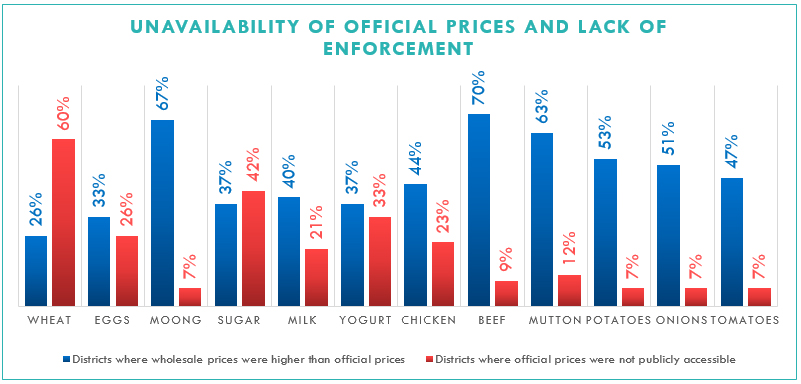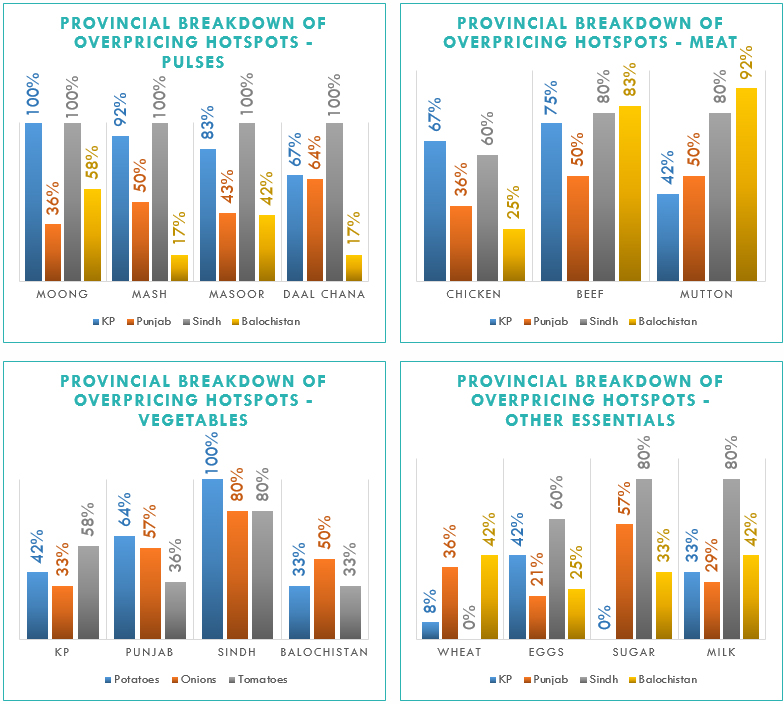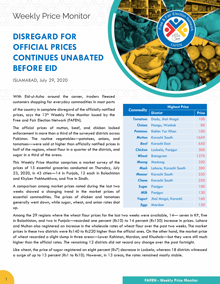ISLAMABAD, July 29, 2020: With Eid-ul-Azha around the corner, traders fleeced customers shopping for everyday commodities in most parts of the country in complete disregard of the officially notified prices, says the 13th Weekly Price Monitor issued by the Free and Fair Election Network (FAFEN).
The official prices of mutton, beef, and chicken lacked enforcement in more than a third of the surveyed districts across Pakistan. The routine vegetables—potatoes, onions, and tomatoes—were sold at higher than officially notified prices in half of the regions, wheat flour in a quarter of the districts, and sugar in a third of the areas.
This Weekly Price Monitor comprises a market survey of the prices of 15 essential groceries conducted on Thursday, July 23, 2020, in 43 cities—14 in Punjab, 12 each in Balochistan and Khyber Pakhtunkhwa, and five in Sindh.
A comparison among market prices noted during the last two weeks showed a changing trend in the market prices of essential commodities. The prices of chicken and tomatoes generally went down, while sugar, wheat, and onion rates shot up.
Among the 29 regions where the wheat flour prices for the last two weeks were available, 14— seven in KP, five in Balochistan, and two in Punjab—recorded one percent (Rs10) to 14 percent (Rs150) increase in prices. Lahore and Multan also registered an increase in the wholesale rates of wheat flour over the past two weeks. The market prices in these two districts were Rs140 to Rs220 higher than the official ones. On the other hand, the market price of wheat recorded a slight slump in three areas—Lower Kohistan, Mardan, and Khushab—but they were still much higher than the official rates. The remaining 12 districts did not record any change over the past fortnight.
Like wheat, the price of sugar registered an eight percent (Rs7) decrease in Lasbela, whereas 18 districts witnessed a surge of up to 13 percent (Rs1 to Rs10). However, in 13 areas, the rates remained mostly stable.
The chicken market price saw a two percent to 41 percent (Rs4 to Rs115) decline in 17 districts, mostly in Khyber Pakhtunkhwa and Punjab. On the other hand, seven areas, mainly in Sindh and Balochistan, recorded a hike with the highest 45 percent (Rs90) increase in Dadu. However, in five Balochistan districts, the poultry prices remained stable.
Among vegetables, the market price of potatoes remained mostly stable except for the mountainous districts of Khyber Pakhtunkhwa and some regions of Balochistan where they recorded an up to 33 percent (Rs20) increase. The onion prices witnessed a 14 percent (Rs5) to 169 percent (Rs44) rise in 13 districts—four each in Punjab and KP, three in Balochistan, and two in Sindh. However, the prices of tomatoes declined in many areas, the most significant drop of 58 percent (Rs70) in Washuk.
The officially notified price lists of wheat flour, sugar, and chicken were unavailable in various parts of the country during the reporting week. The official prices of 20-kilogram wheat flour bags were not available in around 60 percent of the surveyed cities. It was most notable in Khyber Pakhtunkhwa and Sindh, where 92 percent and 100 percent of the surveyed markets did not publicly display the lists. Similarly, the wheat prices were missing in 58 percent of Balochistan’s observed markets and 21 percent in Punjab.
The official sugar prices were missing in 42 percent districts—100 percent in KP, 25 percent in Balochistan, 20 percent in Sindh, and 14 percent in Punjab. Similarly, the chicken prices were not obtainable in 23 percent regions overall—58 percent in Balochistan, 20 percent in Sindh, eight percent in Khyber Pakhtunkhwa, and seven percent in Punjab.
The official rates of four pulses—moong, masoor, mash, and chana—were generally available in Khyber Pakhtunkhwa, Punjab, and Sindh. However, more than half of the markets in surveyed cities of Balochistan did not display the official prices of mash and masoor while a third and a fourth of markets did not display the prices of daal chana and daal moong. At the same time, milk and yogurt rates were not publicly obtainable in 21 percent and 33 percent districts, respectively.
Moreover, mutton and beef prices were missing in 12 percent and nine percent of the districts, mostly in Khyber Pakhtunkhwa and Sindh. The official price lists of regular vegetables—potatoes, onions, and tomatoes—were inaccessible in around 25 percent of the Balochistan markets while elsewhere they were publicly available.

The lax enforcement of official prices burdened the ordinary citizens as traders sold several commodities at higher rates than the officially notified prices.
Among the routine commodities, the implementation of official prices was the weakest when it came to vegetables, pulses, and meat. Daal moong was overpriced in 67 percent of the surveyed districts, masoor (60 percent), mash (58 percent), and chana (56 percent) of the areas. These four pulses went Rs141 to Rs176 above the official prices. The highest difference in wholesale prices and the official rates was in Karachi South, the most expensive city to shop for pulses after Mastung. Although the pulses’ overpricing was common across provinces, it was most notable in Sindh and Khyber Pakhtunkhwa. The official rates, where available, were disregarded by the traders in the surveyed markets of Sindh.
Potatoes, onions, and tomatoes were overpriced in 53 percent, 51 percent, and 47 percent districts, respectively. The tomatoes rate went Rs90 higher than the notified price in Jhal Magsi, while potatoes and onions were sold Rs30 and Rs20 above the announced prices in Panjgur and Hangu.
In the meat category, beef and mutton (average quality with bone) were overpriced in 70 percent and 63 percent of the surveyed districts, and chicken in 44 percent of areas. Mutton, beef, and chicken were sold at Rs929, Rs180, and Rs112, respectively, above the official rates. The highest difference in the market and the official mutton, beef, and chicken prices was in Karachi’s South, East, and Central districts.
Traders sold wheat flour and refined sugar above the official rates in 26 percent and 37 percent districts. A 20-kilogram bag of wheat flour was priced Rs300 above the official rate in Washuk, and one kilogram of refined sugar Rs22 more than the market price in Karachi South. Wheat price enforcement was the weakest in Punjab and Balochistan, where 36 percent and 42 percent markets sold it above the officially notified rates. The sugar price enforcement was the lowest in Sindh and Punjab, where around 80 percent and 57 percent of markets sold sugar above the official prices.
The market rates of eggs per dozen were above the officially notified prices in 33 percent districts. At the same time, the rates of milk and yogurt were higher than the official ones in 40 percent and 37 percent of the surveyed areas.

TDEA-FAFEN generates the Weekly Price Monitor covering 15 essential kitchen items, including groceries such as wheat, pulses, oil, sugar, and perishable commodities like meat, and vegetables. It does this considering the need for an independent and regular assessment of the availability of such items.
The observers obtain the official prices from the officials of district administrations, or market committees, and collect the wholesale prices through market surveys. In Punjab’s case, the government price app Qeemat Punjab is also used to get the official rates.
To download the report, click here


